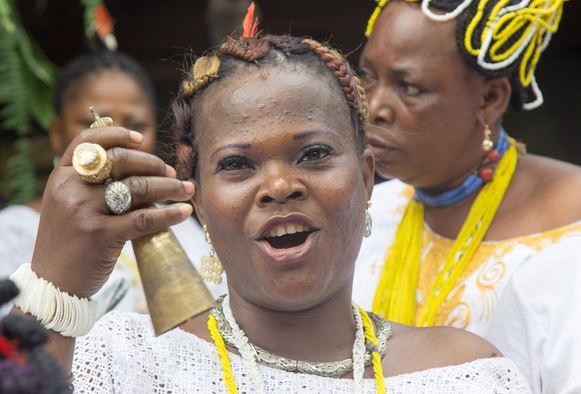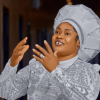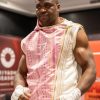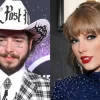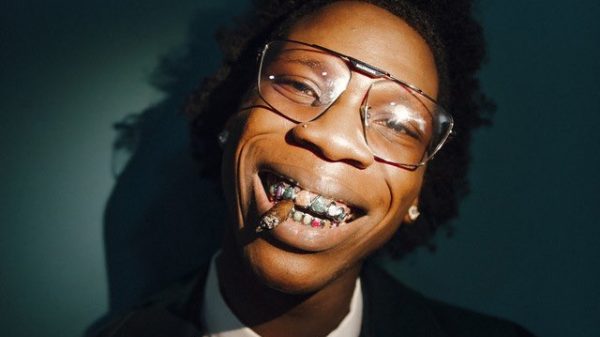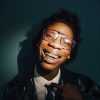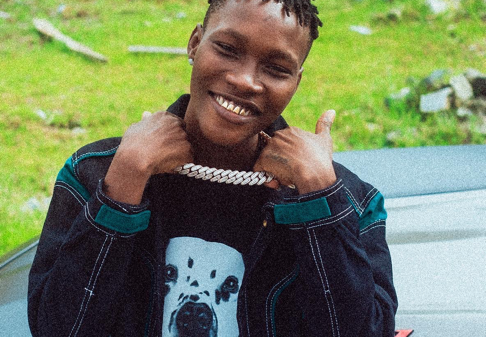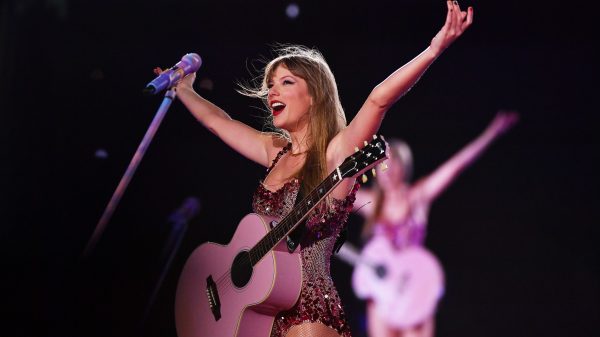 TVC E. Cultural reminiscences and re-awakenings herald the first and second phases of Osogbo Art at 50 celebrations which commenced at the Centre for Black Culture and
TVC E. Cultural reminiscences and re-awakenings herald the first and second phases of Osogbo Art at 50 celebrations which commenced at the Centre for Black Culture and The Osogbo Art movement is one of the world’s prominent art traditions and that is no exaggeration. Oral and written narratives point to the root of the movement namely, the early experimental art workshops organised by the expatriate art teacher from the University College Ibadan, Ulli Beier and the story is not complete without the mention of his first wife, Susanne Wenger and the second, Georgina Betts who contributed to the epoch-making history. They didn’t set out to form a movement. All they wanted to do was to engage the young boys and girls at the Duro Ladipo Theatre in some art works during the long hours between drama rehearsals. The result is a beautiful spot for the movement on world’s cultural map.
In the manner of children listening to folktales from a master story-teller, a sizable number of journalists, who arrived early at the venue of the celebrations marking the fifty years of Osogbo Art, surrounded one of the surviving legends of the Osogbo Art movement, Chief Muraina Oyelami. At the newly revived Centre for Black Culture and International Understanding (CBCIU) in Osogbo, his works were already mounted in the exhibition hall as he delightedly walked in to find several waiting eyes. His humble reciprocation of the courteous greeting accorded to him by this reporter, the youngest of the lot, provoked some grunts of bewilderment from those who know him better.
Before his arrival, a tour of the abandoned facility was heart-breaking for those who knew the former state of the centre which was commissioned in March, 2009 by Koichuro Matsuura, who was the Director-General of UNESCO. Some parts of the centre, which was built to retrieve and curate historic cultural assets, had in abundance wild grasses, flaked doors and vacant administrative blocks. You may add to the list unemployed artists, uncurated works and a stagnant pool of knowledge. What the centre was known for in its first few years include international conferences, vibrant performances and great repute. However, a lingering litigation on the management of the centre had stalled the flow of cultural activities. The details constitute a big story for another day.
In a determined attempt to restore and preserve the glory of the cultural hub, the Chairman, CBCIU and former Governor, Osun State, Prince Olagunsoye Oyinlola, rallied the art community to the launch of the latest journals published by CBCIU, a public presentation of Orisa Dances of Yorubaland in DVDs and the exhibition of the works of the two great artists of the Osogbo movement, Chiefs Muraina Oyelami and Jimoh Braimoh
Chief Oyelami shared some slices of history of the Osogbo Art movement. With mathematical accuracy, the movement is beyond five decades. Nonetheless, the importance of the celebrations cannot be overstated.
“It is important so that we can remember the historical background of how we all started and the contributions of people like Ulli Beier, Georgina Beier, Susanne Wenger and some writers including the forerunners of Mbari Ibadan such as Prof Soyinka and J.P. Clark . Mbari means ‘creation’ in Ibo. When Duro Ladipo and Ulli Beier came to establish the work in Oshogbo, it was changed to Mbari Mbayo which means when I see it, I will be happy,’’ he began.
Oyelami is one of the few contemporaries of Ulli Beier, a German-Jew who played a pioneering role in the movement. The artist recalled the circumstances that led to his sojourn to Nigeria where he discovered and acknowledged the rich cultural deposit that were clearly untapped.
“I worked with him for decades. I know a lot about him and even visited his parents before they died. I think the way he was brought up made him become a sort of adventurer. He was taken out of Germany during the Nazi war and he was born into a Jewish family. Because of the holocaust, he was sent to Palestine to go and work with the British soldiers. He took care of cows and horses. From there, he was able to find his way to England,’’ he recounted.
In Palestine, Beier’s family members were detained as enemy aliens the British authorities. Later, Beier earned a BA as an external student from the University of London. He later moved to London to earn a graduate degree in Phonetics where he realized that war veterans were being given precedence in academic jobs.
“It was in England that he got the advertisement from foreign office that there was a vacancy at Ibadan and that was how he came to Nigeria,’’ he continued. “On the one hand, Susan Wenger, a well- established Austrian artist whom he met in Paris became his friend. She knew Beier was coming to Nigeria and she was also adventurous. That was how they both came to Nigeria in 1950 and settled in University College Ibadan. The environment reminded them of the typical example of the European ways so they wanted something African. They wanted to live every close to the natives. He designed a programme that would allow him to travel round Yorubaland and that was how he got this extra mural studies started. He organised it in Osogbo, Ibadan, Ede, Ikare and Ekiti.’’
Oyelami recalled that Beier became drawn to Duro Ladipo, a student teacher who owned a pub called Popular Bar. Since Beier loved his beer, the love was extended to Ladipo whose intoxication with drama and theatre practice made him a reference point in postcolonial drama history in Nigeria. Ladipo gladly formed a club that attracted writers and artists. Later, visual arts took shape in Osogbo with artists who participated in the first series of experimental art workshops.
“Jacob Lawrence, that favourite black American artist was invited to Ibadan where they conducted an art workshop. Giants like Bruce Onobrakpeya took part in that workshop. Same thing was done here by Ulli Beier. Jacob Afolabi and Rufus Ogundele were discovered as artists. I was there as an actor and a drummer. Chief Jimoh Braimoh was our technical manager in the theatre and Twin Seven Seven came by accident. We were having this get together for Professor Michael Crowther who was transferred to Faraday College and local band was performing. We were preparing to go to the festival of arts in Berlin in 1964 and the guy came as a dancer for a local group and he jumped on the arena and he made some fantastic movement and he was carried away.
“In order that we would find him when we returned from Germany, we lured him into staying around in Paris and bought him musical instrument. He didn’t even know how to play the guitar, it was an acoustic guitar. That was how he came into Mbari club and the rest is history,’’ he recounted.
Oyelami claimed that the most successful workshop was held in 1964 where artists worked with different media, freely without the intrusion of their tutors who occasionally offered advice and encouragement.
Chief Jimoh Braimoh, another of the living legends of the Osogbo Art Movement, corroborated the story. He was glad that the CBCIU, which should be the rightful home of the works of Ulli Beier, has finally come alive.
“We are here to showcase our works and train others. We have so many artists that should have been part of this exhibition but unfortunately many of them have passed. Sadly, their works are not there. Our intention is to bring everybody together. We are still going to plan a larger one that will contain everyone in Abuja. We are waiting to have a permanent place where all these works can be kept so that anyone who wants to see all the works of Osogbo artists can see them. My style is different from Muraina’s. That is why Osogbo is unique. It is different from any other art movement,’’ he said.
Nike Okundaye is often associated with the Osogbo Art Movement. Meanwhile, she was married to one of the best known artists of the Osogbo School, Taiwo Olaniyi popularly known as Twin Seven Seven, who earned his nickname from being the only surviving of the seven sets of twins born by his mother. She was part of the tie and dye movement and learnt from her husband the techniques of painting.
“All of us were involved in theatre. Ulli Beier made backdrops for the theatre. Afolabi Jacob and Rufus Ogundele took place in the 1963. Those were the original six. We cannot say Nike is not part of us. We call her Osun,’’ he said.
Braimoh served as stage manager for the Duro Ladipo theatre and worked closely with Rufus Ogundele, Muraina Oyelami, Adebisi Fabunmi, Afolabi Jacob and Taiwo Olaniyi who made up the pioneering artists of the Osogbo movement in art.
For the chairman CBCUI, Prince Olagunsoye Oyinlola, the fact that the Governor of Osun state, Rauf Aregbesola had supported the relaunch of the centre spells good tidings to the art community. In his address at the august event, he reiterated that the centre will advance cultural knowledge.
“The journals contain research of various issues pertaining to art and culture as contributed by scholars. It is our collective responsibility to preserve our culture and tradition for future generation and to protect the influx of foreign culture which is at an alarming rate.
“I am so sure that we are all concerned about the real and the imagined fears of cultural erosion by foreign influences that are threatening many aspects of our culture including language, performance of traditional rites for different events, traditional health care, traditional songs and poetry, religion and traditional architecture. If our indigenous languages and not well spoken and communicated, the resultant effect will be a complex situation for our society,’’ he said.
He encouraged parents to support their children who may be interested in the study and practice of arts. In his view, knowledge should not be confined to a certain generation.
“A proverb in Yoruba states that akii juba eniti ogbe ogbo los’orun’ meaning ‘nobody acknowledges anyone who dies with his knowledge’. Let me say that CBCIU is proud to see two of the members of its trustees and living legends in the art worlds, chief Jimoh Braimoh and Chief Muraina Oyelami as they will be joined by drummers to train students from primary, secondary and tertiary institutions under the auspices of CBCIU. They will also train professional dancers, artists and cultural troupes all over Nigeria as well as students of theatre art and African studies in other to improve their skills,’’ he said.
Oyinlola promised that the CBCIU will acquire the artifacts of the late Chief Duro Ladipo and other pioneering artists while continuing the tradition of international cultural exchanges.
“The centre will support the quest of making culture and tourism as a major source of revenue for Nigeria. We are strongly committed to supporting the agenda of the Buhari administration by utilising culture and tourism to contribute meaningfully to the diversification of Nigeria’s economy. We will cooperate fully with the Aregbesola administration to grow the culture and tourism sub sectors in the state of Osun. We are sitting on the golden mine of culture and tourism that are one of the world’s biggest economies,’’ he said.
Oyinlola who spoke briefly with journalists at the event revealed that the centre was like a wilderness a week earlier when he was given the consent by the governor to prepare it as the venue for the celebration. He left the journalists with the pledge to renovate the abandoned facility and forge cultural linkages with black cultures in Europe, Americas and the Carribean Islands.
“Chief Muraina is the coordinator of the administrative office for now. That will make the centre a repository of knowledge if we have workshops, exchange programmes and conferences,’’ he said.
The celebrations continued at the prestigious Thought Pyramid Art Centre, Abuja on January 24 with more participating artists from the Osogbo Art movement. The early arrivals did not miss the witty quote by Le Corbuster at the entrance to the gallery, “I prefer drawing to talking. Drawing is faster and leaves less room for lies.’’
One cannot deny that the preparation for the Abuja show was more co-ordinated than its Osogbo opening. From well-labelled paintings to a warm and inviting ambience, the organisers demonstrated forethought in concrete terms.
Away from the paintings, Jeff Ajueshi, the Director of the centre, cured the homesickness of the visiting journalists from Lagos with the rich African cuisine next door to the exhibition hall. The satisfying breakfast made a nap so tempting but the voice of Femi Adelegan who represented, Prince Oyinlola at the event cut through.
“From early to mid-60s, just after Nigeria’s independence in what we can truly call an age of innocence, Osogbo art began to have a trademark that uniquely distinguishes it from other art forms. The Osogbo arts movement, as an informal art offering, coincided with the advent of the formal art school referred to as the Zaria Rebels. However, this did not in any way diminish its independent accomplishment,” he said.
The Director-General, National Gallery of Art, Muku Abdullahi reiterated the importance of the show in repositioning the nation’s economy. While extolling the virtues of the leading six pioneer artists of Osogbo art tradition, he remarked that the school has survived because the artists had made a tremendous impact in global art story.
The Abuja show afforded the arts community the opportunity to appreciate the ingenuity in the artists’ works, their timeliness and place in history. For instance, the wool in the paintings of Adebisi Fabunmi is a testimony to his versatility in the use of medium. Twin Seven Seven’s ink on fabric techniques drew peering eyes to paintings such as The Entertainers, The Blessed Voyager and Village Life Under Cocoa Tree as they gave credence to the artistry of the man who explored animal, plant and human motifs to probe Yoruba mythology.
Rufus Ogundele’s piece, “Puppetier” is an aging 30-year old work, threatened by destruction but standing strong against the wall. Oyelami’s painting titled, “Single Parenthood’’ is still very relevant in thematic preoccupation in a generation where “baby-mammas’’ are subjects of media gossip and public ridicule.
The pupils from Cleverfield school were enthralled at the sight of works as they would enjoy workshop session with the legendary artists.
One of the pleasant surprises in the drama is in the character of Dayo. A very humble Lagos driver and father developed to an avenger who is at risk of imprisonment or deportation to Nigeria. The play drums in the reality that the greener pastures sought by many immigrants can be full of thorns. Patrick Diabuah emerges from the usual role of soulful musical actor in plays like Wakaa and Saro to a vicious street boy in Fractures.


